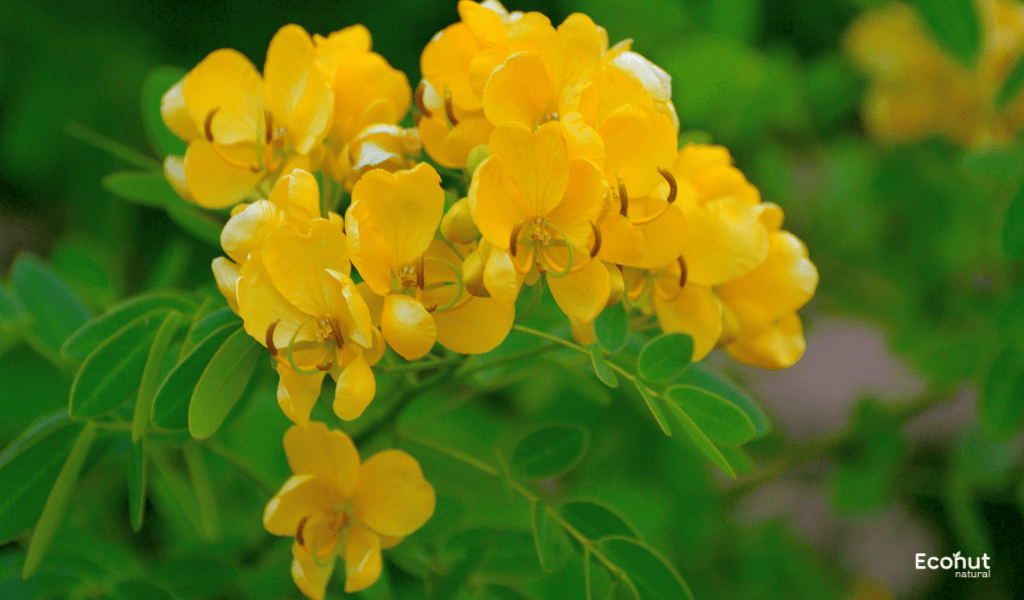Coffee Senna (Cassia occidentalis) is a weed in the Fabaceae family that thrives low to medium elevations in wet, disturbed, or junkyard environments worldwide. Originally found in tropical South America, the plant can be fatal if ingested in large quantities. Despite this, many people use the plant’s parts as food and medicine throughout the world. The seeds are widely substituted for coffee.
Many plants have been utilized in traditional medicine since ancient times, and these herbs include a wide range of phytopharmaceuticals that are important for human health. Out of all these herbs, coffee senna is the most well-known plant with a wealth of therapeutic properties and is regarded as the most potent herb in traditional medicine.
Description
This herb is also known as Negro coffee and coffee weed. Although the leaves are thought to be deadly, people in South India and the Maldives still consume them. It helps with coughing and dyspepsia and balances the three doshas, according to Ayurveda.
Botanical Name:
Cassia occidentalis
Family:
Fabaceae
Leaves:
Because of their pinnate nature, the leaves feature pairs of leaflets placed along a central stalk. Three to seven pairs of roughly elliptic to egg-shaped leaflets, usually measuring 50 to 70 mm in length and 30 to 40 mm in width, make up a coffee senna leaf. Pale green leaves atop reddish stalks are seen.
Flowers:
These are little clusters of bright yellow flowers found on the top leaf forks. There are six viable stamens and five yellow petals on each bloom. Their diameter might vary from 2 to 3 cm.
Stems:
These are erect, reddish-purple, and normally grow in four angles while young, rounding out as the plant gets older. They can grow to a height of 0.5 to 2.5 meters and have silky hair.
Fruits:
The Coffee Senna yields sickle-shaped, dark brown, flattened pods that are 8–10 mm broad and 7.5–13 cm long. When fully grown, these pods have a single row of 25–35 seeds with lighter stripes around the margins.
Seeds:
The seeds are firm, flattened, and dark brown. They are found inside the pods. Typically, they measure 5 mm in length and 3 mm in width.
Habitat:
Weed found in tropical, subtropical, and semi-arid environments; it can be found on roadsides, waste areas, disturbed sites, pastures, grasslands, open woods, and coastal areas.
Parts Used:
- Root
- Seed
- Leaf
Dosage:
- Seed powder – 3-6 gm
- Root decoction – 40-80 ml
- Leaf juice extract – 10-20 ml
Chemical Constituents
Cassiollin, Physcion, tannic acid, Phytosphanol, Occidentol , mucilage, and Emodin
Sanskrit Synonyms
Kasaghna– helps to relieve cough
Arimarda– treats pain
Other synonyms – Kasamarda, Kasari, Kasamardika, Kataka, Karkasha, and Kasamard.
Other Language Names of Coffee Senna (Cassia occidentalis)
Hindi name – Kasoundi
Urdu name – Kasonji
Tamil name – Peyaveri
Kannada name – Kasamarada Gida, Elemuri soppu
Assamese name – Hant theng
Gujarati name – Kasondari
Telugu name – Kasind, Kasavinda
Bengali name – Kesenda
Marathi name – Kasvida
Scientific Classification
| Kingdom | Plantae |
| Phylum | Tracheophyta |
| Class | Magnoliopsida |
| Order | Fabales |
| Family | Fabaceae |
| Subfamily | Caesalpinioideae |
| Genus | Senna |
| Species | Senna occidentalis |
Ayurvedic Properties
Rasa (taste) – Madhura (sweet) and Tikta (Bitter)
Guna (qualities) – Rooksha (Dryness) and Laghu (light)
Veerya (Potency) – Ushna (Hot)
Vipaka (Undergoes taste conversion after digestion) – Katu (Pungent)
Effect on Tridosha -Tridoshahara (Balances all the three Doshas)
Coffee Senna (Cassia occidentalis) Uses
- For the treatment of colic pain, a paste made from the leaves of this plant should be given twice a day at a quantity of 1 gram.
- This plant’s roots are used as a diuretic and tonic for sporadic fevers.
- Ten grams of the plant’s powdered root are chewed three times a day for three days after a snake bite.
- Its seeds are used to cure heart conditions, whooping cough, and other ailments.
- For diabetes, its bark infusion is beneficial.
Coffee Senna (Cassia occidentalis) Benefits
Asthma:
Coffee Senna helps manage symptoms associated with asthma. It facilitates breathing and clears the impediment from the route.
Eliminates parasites:
Additionally beneficial to people with intestinal parasitic worms is senna occidentalis. It can ease distension and cramping in the stomach.
Diabetes:
Coffee Senna bark infusion is utilized to maintain insulin level management. Managing your blood sugar levels within a reasonable range also helps to control your diabetes symptoms.
Indigestion:
Indigestion is a condition brought on by inadequate digestion of food. The main cause of this condition is weak digestive fire, or Agnimandiya. Due to its Ushna (heating) and Pachan (digestive) qualities, which increase Agni, the digestive fire, Coffee Senna helps control indigestion by improving digestion.
Reduces inflammation:
Senna occidentalis has the ability to lower inflammation in the body, which is why it is frequently used to lower the risk of cancer and heart disease. Edema and joint pain have also reportedly been alleviated by sensna occidentalis.
Fever:
Coffee Senna roots have an antipyretic effect, which helps people with intermittent fever by lowering body temperature.
Cough:
Cough is a frequent illness that typically results from a change in the temperature or weather. In Ayurveda, it is referred to as a Kapha illness and is usually brought on by a buildup of mucus in the respiratory system as a result of an imbalance in Kapha-dosha. Kasmard’s Ushna (heat) and Kapha balancing qualities aid in the management of cough. The plant relieves coughing and makes it easier to remove extra mucus from the respiratory system.
Don’t miss: Slippery Elm – Benefits, Uses & Side Effects
Coffee Senna (Cassia occidentalis) Side Effects
Allergic reaction:
An allergic reaction to coffee senna might cause breathing difficulties, facial or lip swelling, and hives.
Muscle weakness:
Coffee senna has the potential to produce muscle weakness, particularly in those who are currently using drugs that have this potential.
Pregnant women:
Uterine contractions brought on by coffee senna have the potential to result in miscarriage or an early birth.
Conclusion
Strong ayurvedic medicine known as “kasmard,” or Cassia occidentalis, guards the body against numerous harmful fungus and at least nine distinct human pathogenic germs. In addition to treating whooping cough and fever, this plant’s leaves, roots, and seeds have purgative properties. The root infusion is thought to act as a poison’s counter-advise. Kasmard root is used to cure fevers and is a diuretic. Scabies, ringworm, and other skin conditions are treated externally using leaves.
FAQS
What is coffee senna used for?
The seeds are frequently used in place of coffee. The dried flowers and root are made as a kind of tea to cure circulatory, digestive, and viral disorders. Use the roots and petals to make poultices to treat skin conditions like eczema.
What negative affects does coffee Senna have?
Some adverse effects that may arise from it include diarrhea, cramping, and upset stomach. When taken for more than a week or in amounts greater than 34.4 mg of sennosides twice daily, senna may be harmful.
How do the seeds of Coffee Senna alleviate constipation?
Its seeds contain anthraquinone, which has purgative qualities that cause feces to loosen and enhance bowel movements.

